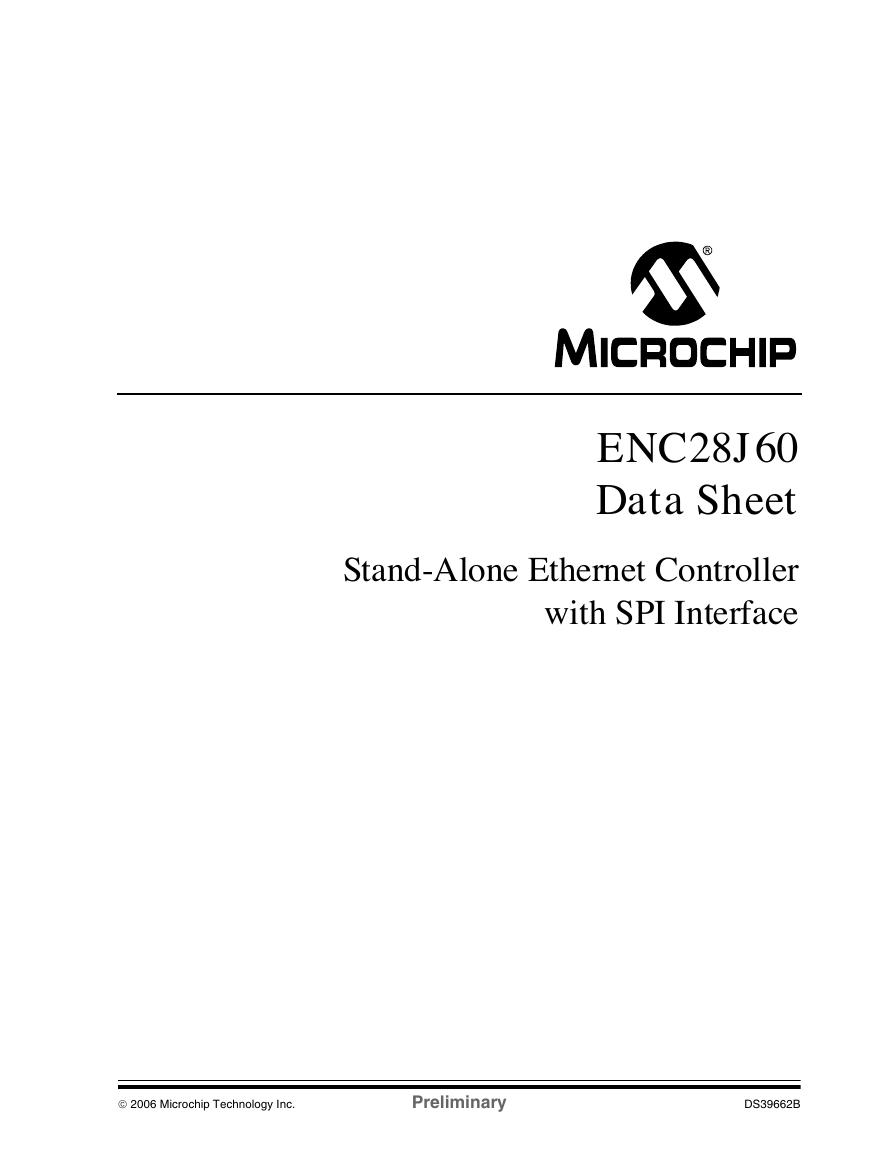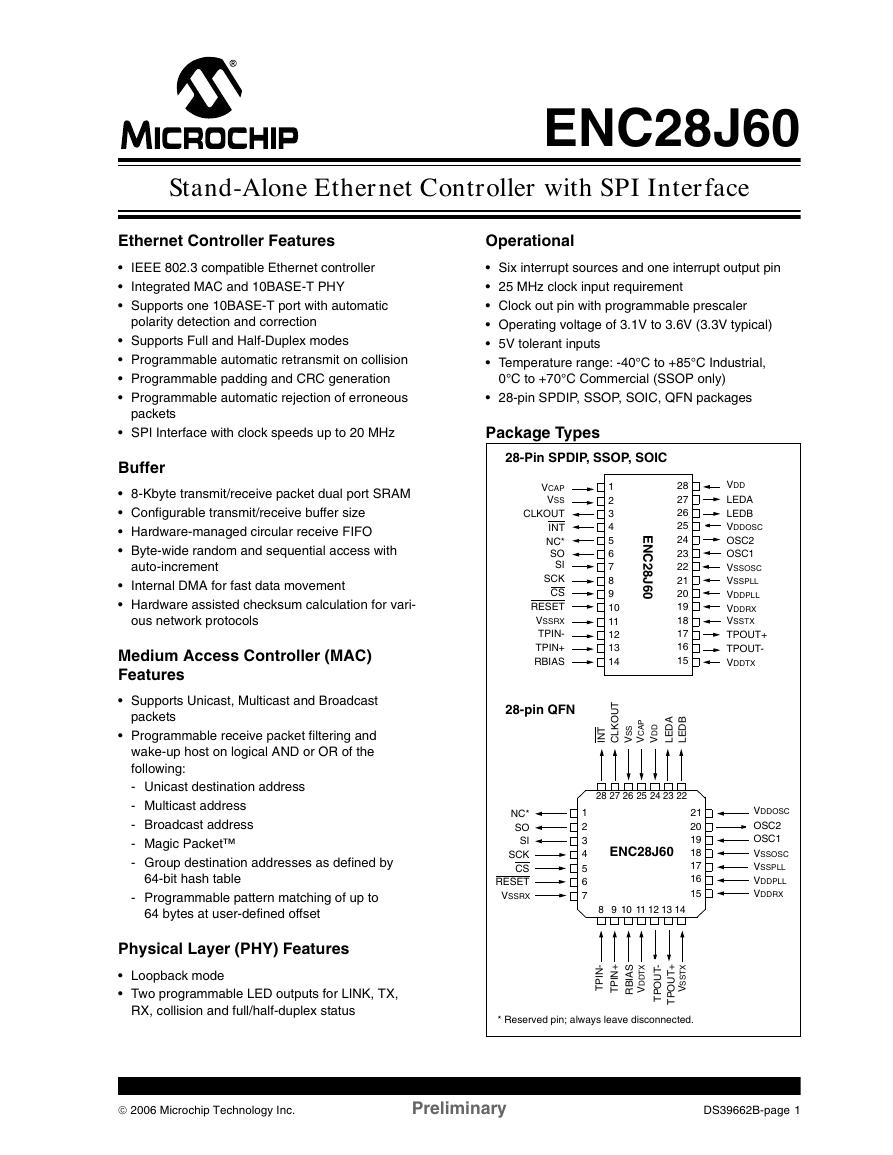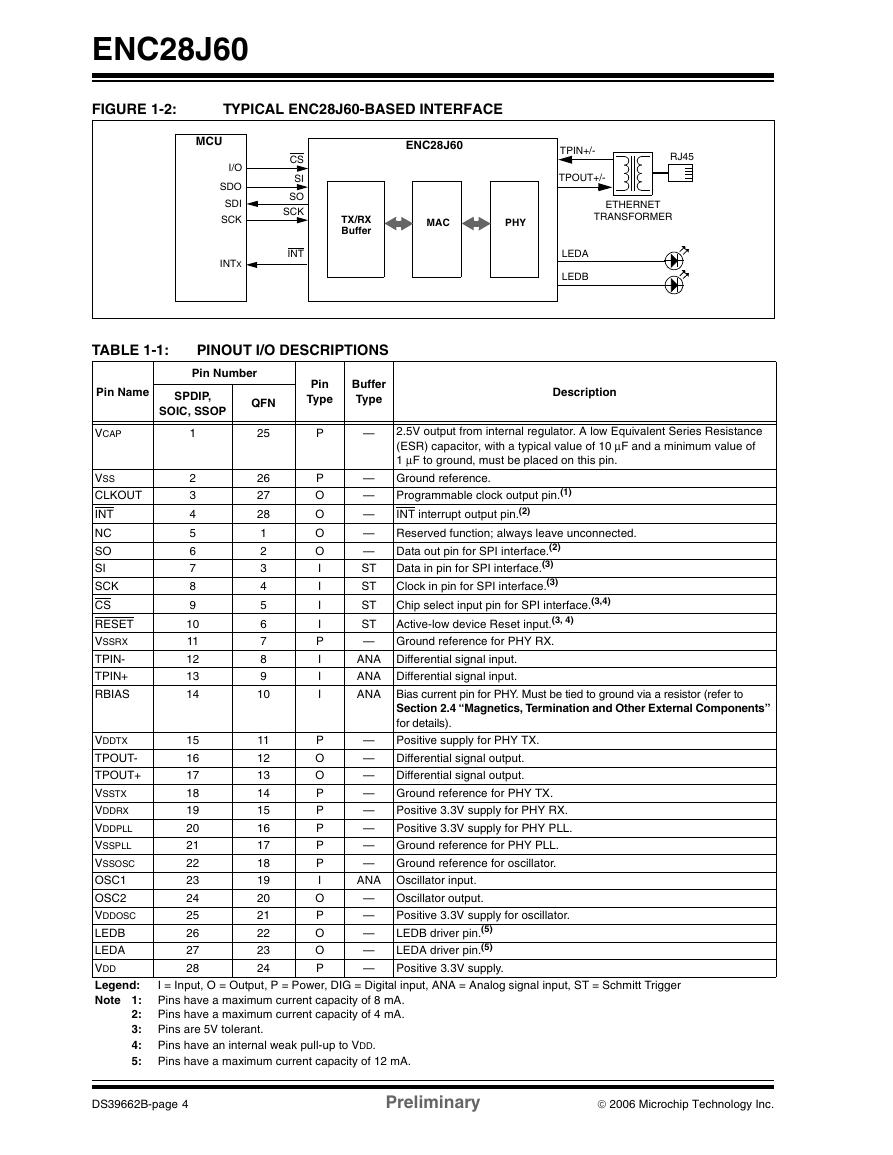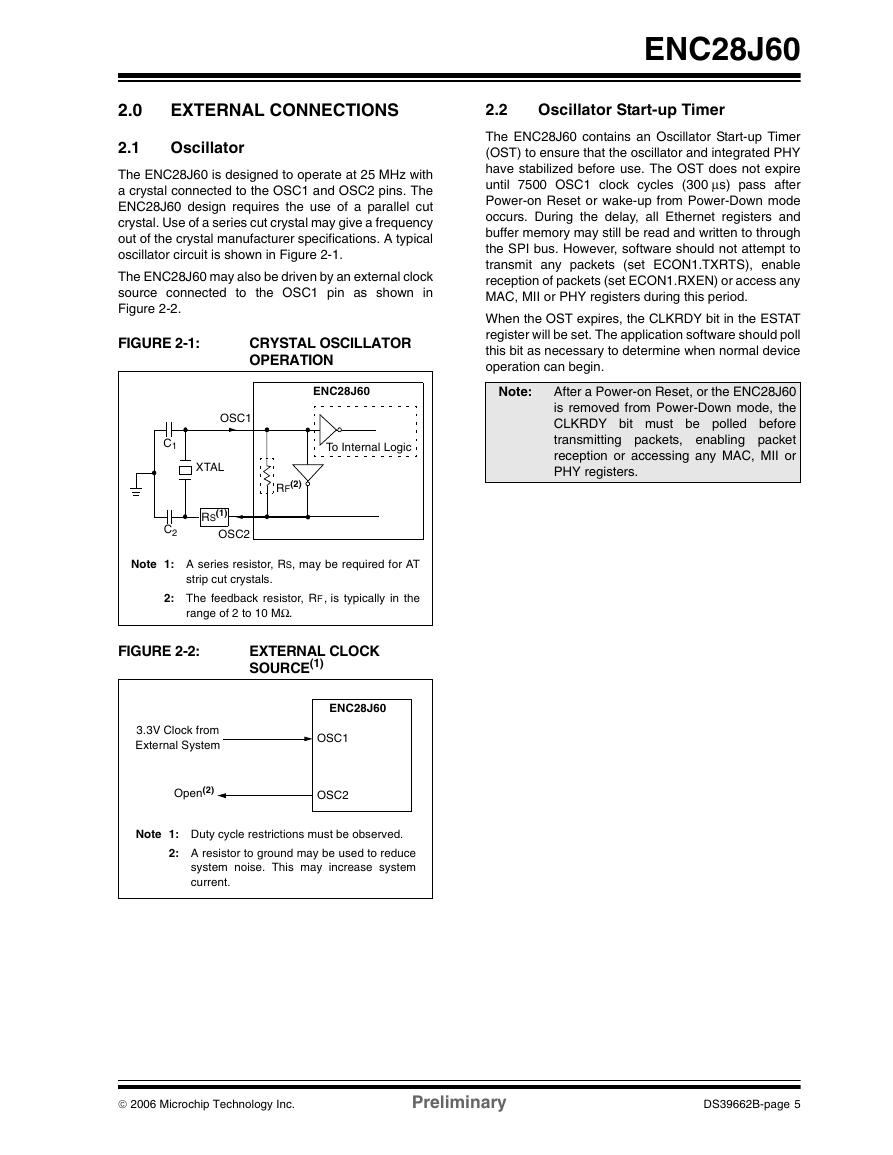Ethernet Controller Features
Buffer
Medium Access Controller (MAC) Features
Physical Layer (PHY) Features
Operational
Package Types
Table of Contents
Most Current Data Sheet
Errata
Customer Notification System
1.0 Overview
FIGURE 1-1: ENC28J60 Block Diagram
FIGURE 1-2: Typical ENC28J60-Based Interface
TABLE 1-1: Pinout I/O Descriptions
2.0 External Connections
2.1 Oscillator
FIGURE 2-1: Crystal Oscillator Operation��
FIGURE 2-2: External Clock Source(1)��
2.2 Oscillator Start-up Timer
2.3 CLKOUT Pin
FIGURE 2-3: CLKOUT Transition
Register 2-1: ECOCON: Clock Output Control Register
2.4 Magnetics, Termination and Other External Components
FIGURE 2-4: ENC28J60 Ethernet Termination and External Connections
2.5 I/O Levels
FIGURE 2-5: Level Shifting Using AND Gates
FIGURE 2-6: Level Shifting Using 3-State Buffers
2.6 LED Configuration
FIGURE 2-7: LEDB Polarity and Reset Configuration Options
TABLE 2-1: LED Blink Stretch Length
Register 2-2: PHLCON: PHY Module LED Control Register��
3.0 Memory Organization
FIGURE 3-1: ENC28J60 Memory Organization
3.1 Control Registers
TABLE 3-1: ENC28J60 Control Register Map
TABLE 3-2: ENC28J60 Control Register Summary�
3.1.1 ECON1 Register
Register 3-1: ECON1: Ethernet Control Register 1�
3.1.2 ECON2 Register
Register 3-2: ECON2: Ethernet Control Register 2�
3.2 Ethernet Buffer
3.2.1 Receive Buffer
3.2.2 Transmit Buffer
3.2.3 Reading and Writing to the Buffer
3.2.4 DMA Access to the Buffer
FIGURE 3-2: Ethernet Buffer Organization
3.3 PHY Registers
3.3.1 Reading PHY Registers
3.3.2 Writing PHY Registers
3.3.3 Scanning a PHY Register
TABLE 3-3: ENC28J60 PHY Register Summary
Register 3-3: MICMD: MII Command Register�
Register 3-4: MISTAT: MII Status Register�
3.3.4 PHSTAT Registers
3.3.5 PHID1 and PHID2 Registers
Register 3-5: PHSTAT1: Physical Layer Status Register 1�
Register 3-6: PHSTAT2: Physical Layer Status Register 2�
4.0 Serial Peripheral Interface (SPI)
4.1 Overview
FIGURE 4-1: SPI Input Timing
FIGURE 4-2: SPI Output Timing
4.2 SPI Instruction Set
TABLE 4-1: SPI Instruction Set for the ENC28J60
4.2.1 Read Control Register Command
FIGURE 4-3: Read Control Register Command Sequence (ETH Registers)
FIGURE 4-4: Read Control Register Command Sequence (MAC and MII Registers)
4.2.2 Read Buffer Memory Command
4.2.3 Write Control Register Command
FIGURE 4-5: Write Control Register Command Sequence
4.2.4 Write Buffer Memory Command
4.2.5 Bit Field Set Command
4.2.6 Bit Field Clear Command
FIGURE 4-6: Write Buffer Memory Command Sequence
4.2.7 System Reset Command
FIGURE 4-7: System Reset Command Sequence
5.0 Ethernet Overview
5.1 Packet Format
5.1.1 Preamble/Start-of-Frame Delimiter
FIGURE 5-1: Ethernet Packet Format
5.1.2 Destination Address
5.1.3 Source Address
5.1.4 Type/Length
5.1.5 Data
5.1.6 Padding
5.1.7 CRC
6.0 Initialization
6.1 Receive Buffer
6.2 Transmission Buffer
6.3 Receive Filters
6.4 Waiting For OST
6.5 MAC Initialization Settings
Register 6-1: MACON1: MAC Control Register 1�
Register 6-2: MACON3: MAC Control Register 3�
Register 6-3: MACON4: MAC Control Register 4�
Register 6-4: MABBIPG: MAC Back-to-back Inter-packet GAP Register�
6.6 PHY Initialization Settings
Register 6-5: PHCON2: PHY Control Register 2
7.0 Transmitting and Receiving Packets
7.1 Transmitting Packets
FIGURE 7-1: Format for Per Packet Control Bytes
FIGURE 7-2: Sample TRansmit Packet Layout
TABLE 7-1: Transmit Status Vectors
TABLE 7-2: Summary of Registers Used for Packet Transmission�
7.2 Receiving Packets
7.2.1 Enabling Reception
7.2.2 Receive Packet Layout
FIGURE 7-3: Sample Receive Packet Layout
TABLE 7-3: Receive Status Vectors
7.2.3 Reading Received Packets
EXAMPLE 7-1: Random Access Address Calculation
7.2.4 Freeing Receive Buffer Space
7.2.5 Receive Buffer Free Space
EXAMPLE 7-2: Receive Buffer Free Space Calculation
TABLE 7-4: Summary of Registers Used for Packet Reception
8.0 Receive Filters
Register 8-1: ERXFCON: Ethernet RECEIVE FILTER CONTROL REGISTER�
FIGURE 8-1: Receive Filtering Using OR Logic
FIGURE 8-2: Receive Filtering Using AND Logic
8.1 Unicast Filter
8.2 Pattern Match Filter
FIGURE 8-3: Sample Pattern Match Format
8.3 Magic Packet™ Filter
FIGURE 8-4: SAMPLE MAGIC PACKET™ Format
8.4 Hash Table Filter
8.5 Multicast Filter
8.6 Broadcast Filter
9.0 Duplex Mode Configuration and Negotiation
9.1 Half-Duplex Operation
9.2 Full-Duplex Operation
10.0 Flow Control
10.1 Half-Duplex Mode
10.2 Full-Duplex Mode
FIGURE 10-1: Sample Full-Duplex Network
Register 10-1: EFLOCON: Ethernet Flow Control Register�
TABLE 10-1: Summary of Registers Used with Flow Control
11.0 Reset
FIGURE 11-1: On-Chip Reset Circuit
11.1 Power-on Reset (POR)
11.2 System Reset
11.3 Transmit Only Reset
11.4 Receive Only Reset
11.5 PHY Subsystem Reset
Register 11-1: PHCON1: PHY Control Register 1
12.0 Interrupts
FIGURE 12-1: ENC28J60 Interrupt Logic
12.1 INT Interrupt Enable (INTIE)
12.1.1 INT Interrupt Registers
Register 12-1: ESTAT: Ethernet Status Register�
Register 12-2: EIE: Ethernet Interrupt Enable Register�
Register 12-3: EIR: Ethernet Interrupt Request (Flag) Register�
Register 12-4: PHIE: PHY Interrupt Enable Register�
Register 12-5: PHIR: PHY Interrupt Request (Flag) Register�
12.1.2 Receive Error Interrupt Flag (RXERIF)
12.1.3 Transmit Error Interrupt Flag (TXERIF)
12.1.4 Transmit Interrupt Flag (TXIF)
12.1.5 Link Change Interrupt Flag (LINKIF)
12.1.6 DMA Interrupt Flag (DMAIF)
12.1.7 Receive Packet Pending Interrupt Flag (PKTIF)
12.2 Wake-On-LAN/Remote Wake-up
12.2.1 Setup Steps for Waking Up on a Magic Packet
13.0 Direct Memory Access Controller
13.1 Copying Memory
13.2 Checksum Calculations
TABLE 13-1: Summary of Registers Associated with the DMA Controller
14.0 Power-Down
TABLE 14-1: Summary of Registers Used with Power-Down
15.0 Built-in Self-Test Controller
Register 15-1: EBSTCON: Ethernet SELF-TEST CONTROL REGISTER�
15.1 Using the BIST
15.2 Random Data Fill Mode
15.3 Address Fill Mode
15.4 Pattern Shift Fill Mode
TABLE 15-1: Summary of Registers Associated with the Self-Test Controller
16.0 Electrical Characteristics
Absolute Maximum Ratings
16.1 DC Characteristics: ENC28J60 (Industrial and Commercial)�
TABLE 16-1: AC Characteristics: ENC28J60 (Industrial and Commercial)
TABLE 16-2: Oscillator Timing Characteristics��
TABLE 16-3: Reset AC Characteristics��
TABLE 16-4: CLKOUT Pin AC Characteristics��
TABLE 16-5: Requirements for External Magnetics��
FIGURE 16-1: SPI Input Timing�
FIGURE 16-2: SPI Output Timing�
TABLE 16-6: SPI Interface AC Characteristics��
17.0 Packaging Information
17.1 Package Marking Information
17.2 Package Details
28-Lead Skinny Plastic Dual In-line (SP) – 300 mil Body (PDIP)
28-Lead Plastic Small Outline (SO) –�Wide, 300 mil Body (SOIC)
28-Lead Plastic Shrink Small Outline (SS) – 209 mil Body, 5.30 mm (SSOP)
28-Lead Plastic Quad Flat No Lead Package (ML) 6x6 mm Body (QFN) – With 0.55 mm Contact Length (S...
INDEX
The Microchip Web Site
Customer Change Notification Service
Customer Support
Reader Response
Product Identification System
Worldwide Sales and Service
















 V2版本原理图(Capacitive-Fingerprint-Reader-Schematic_V2).pdf
V2版本原理图(Capacitive-Fingerprint-Reader-Schematic_V2).pdf 摄像头工作原理.doc
摄像头工作原理.doc VL53L0X简要说明(En.FLVL53L00216).pdf
VL53L0X简要说明(En.FLVL53L00216).pdf 原理图(DVK720-Schematic).pdf
原理图(DVK720-Schematic).pdf 原理图(Pico-Clock-Green-Schdoc).pdf
原理图(Pico-Clock-Green-Schdoc).pdf 原理图(RS485-CAN-HAT-B-schematic).pdf
原理图(RS485-CAN-HAT-B-schematic).pdf File:SIM7500_SIM7600_SIM7800 Series_SSL_Application Note_V2.00.pdf
File:SIM7500_SIM7600_SIM7800 Series_SSL_Application Note_V2.00.pdf ADS1263(Ads1262).pdf
ADS1263(Ads1262).pdf 原理图(Open429Z-D-Schematic).pdf
原理图(Open429Z-D-Schematic).pdf 用户手册(Capacitive_Fingerprint_Reader_User_Manual_CN).pdf
用户手册(Capacitive_Fingerprint_Reader_User_Manual_CN).pdf CY7C68013A(英文版)(CY7C68013A).pdf
CY7C68013A(英文版)(CY7C68013A).pdf TechnicalReference_Dem.pdf
TechnicalReference_Dem.pdf